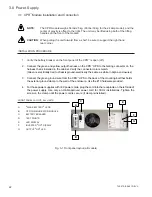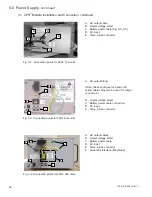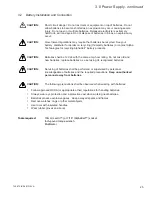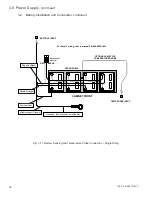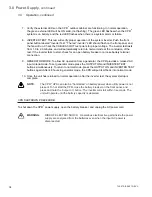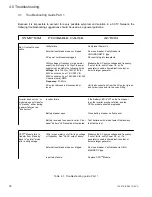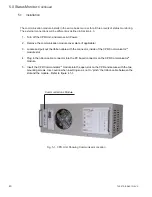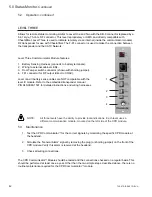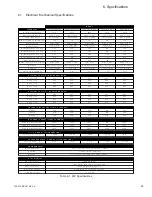
35
3.0 Power Supply
,
continued
745-573-B0-001 REV. A
NOTE:
It is important that secure mechanical and electrical connections be maintained on
this equipment. Secure connections will help prevent outages and equipment
damage. Refer to the following page for a sample of a maintenance log sheet.
1.
Inspect the external ground connections for mechanical integrity and good physical condition.
Check the cabinet for damage and check the mounting hardware for mechanical integrity.
2.
Open the cabinet. Check tightness of all battery, internal ground, and output connections.
Observe condition of batteries. If the cabinet shows signs of excessive dust or moisture, check
for lost vent screens. Repair as required, and note any unusual conditions for future reference.
3.
Inspect the input surge suppressor (if installed) for obvious damage. If it appears intact, check
its operation with a megger or a similar device to ensure that it is functioning. Note that a failed
surge suppressor may appear visually to be OK, yet allow damaging transients and surges to
enter the power supply, and possibly the coax network.
It is very important to test the surge
suppressor with a megger to make sure it is actually protecting the power supply.
4.
On the maintenance log sheet, mark which LEDs are illuminated on the front panel of the CPR
TM
UPS. The presence of any red LED indicates an alarm or failure which will require immediate
attention. See Section 4.1 for troubleshooting information.
5.
The CPR
TM
system will automatically and periodically load test the batteries. If a failing battery is
detected, the battery LED (red) on the front panel will illuminate. If the battery LED is
illuminated, replace the affected battery (or string of batteries) and press the “battery LED reset”
button on the front panel. See Section 3.2.1 for the battery removal procedure.
6.
Use a true RMS meter to record AC output voltage and battery voltage at the front panel test
points. If available, use a clamp-on current probe to record AC output current at the cable
adapter.
7.
Turn the battery circuit breaker off (down). Record the voltage for each battery (well matched
batteries should differ by no more than 0.2 Vdc). If the battery has a date code on the label,
record it on the maintenance log sheet.
8.
Using a battery load tester, check the performance of each battery. Note that the CPR UPS
performs battery load testing automatically, so this step may be omitted if desired.
9.
Close the battery circuit breaker on the front panel.
10. Force the unit into standby operation by pressing the “inverter test” button on the front panel.
Verify that the red inverter LED illuminates and that the output voltage remains /- 3-5%
of the nominal voltage (48, 60, 75 or 87 VAC). Verify the unit returns automatically to normal
operation after 1 to 2 minutes.
11. Confirm that only GREEN LEDs are illuminated, remove all tools and meters, and close and lock
the cabinet. This completes routine maintenance of the CPR
TM
power supply.
3.4
Maintenance
3.4.1
Routine Maintenance Checks


